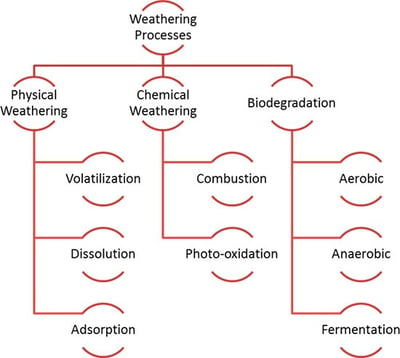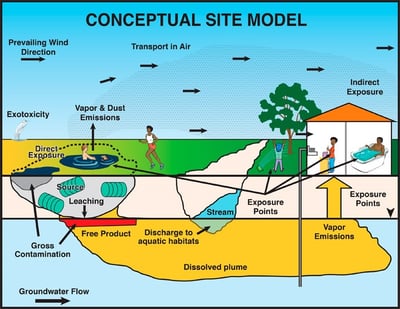Petroleum hydrocarbons are unique in environmental assessment and management because their complex mixtures of compounds and wide-ranging chemical and physical properties. Once released into the environment, these mixtures and their properties can change through several processes referred to as weathering, which makes evaluating them even more difficult. The figure below shows the complexity of the weathering process.

Weathering processes that can affect hydrocarbon mixtures (Source: U. Johnson, Georgia EPD, 2018)
Total petroleum hydrocarbons (TPH) is an estimation of these cumulative mixtures. Quantifying and analyzing TPH does not usually identify the individual constituents, but rather is the measurable amount of all hydrocarbons in an environmental media. This creates dependency on the analytical method used to measure TPH. A given method may not only account for hydrocarbons, but it also can include nonhydrocarbons such as organic matter, petroleum-derived metabolites and other chemicals.
Because of TPH’s inconsistency of composition, assessing health effects and target levels or development of screening levels is difficult. Assigning TPH into fractions or groups of compounds based on analytical, fate and transport, and exposure considerations is a common approach to narrow the criteria of which can be applicable in a given instance.
 Conceptual site model showing the migration pathways of petroleum from source to receptors (Source: ITRC Figure 5-1)
Conceptual site model showing the migration pathways of petroleum from source to receptors (Source: ITRC Figure 5-1)
Interpreting the results of TPH and performing risk assessments of TPH pose many challenges. Three of the most common and important include:
- Complexity and variability of petroleum releases
- Composition of any given petroleum mixture can substantially change over time due to “weathering”
- Potentially substantial and selective partitioning of mixture components as they travel from media to media
TPH releases can range from single-event petroleum releases to long-term discharges, which influences exposure. Ecological risk assessments (ERAs) evaluate habitats, trophic levels and, most important, representative species. Each species exposed could have a different response to TPH, which makes TPH-focused ERAs very challenging.
The influence of these short-term and long-term releases vary in many ways and can both cause harmful ecological effects. Short-term releases of TPH smother invertebrates and can cause a reduction in insulation of avian feathers, whereas long-term releases are likely to have chronic effects on aquatic communities, which may be subtle and more difficult to identify.

Aside from environmental effects at TPH sites, stakeholders may have questions and concerns related to human health. The generation of gases such as methane in the subsurface as a byproduct of biodegradation may require further communication of risk. Public mistrust of modeling to make management decisions is also a very serious concern at TPH projects, especially if no implemented investigation is documented. Devaluation of homes and land is a common concern of property owners, who assume remedial actions will be minimized in an effort to cut costs by the responsible party. TPH- contamination sites can be located in areas that can affect the public. Property owners and stakeholders may have a wide variety of questions and concerns regarding TPH contamination, potentially stemming from a lack of understanding of TPH biodegradation and remedial approaches. Lacking representative and quantitative data can create uncertainty that can lead to future problems for landowners, tenants and other stakeholders. One such example would be future property transactions, as the value of these transactions can fluctuate based on harmful environmental impacts to the property.
All TPH projects should immediately identify all stakeholders involved, which can include local law enforcement, water utilities, local government, health departments, etc. Being as inclusive and communicable as possible, as well as awareness of varying levels of technical understanding will sincerely help these projects. Readiness and willingness to communicate within these varying levels, as well as the efficient demonstration of investigative measures, are key fundamentals in TPH risk assessment and remedial processes.
While TPH can be a valuable screening tool at many contaminated sites, it has its shortcomings and must be used in the correct manner and often in conjunction with additional, more precise and indicative analytes.
https://tphrisk-1.itrcweb.org/
https://tphrisk-1.itrcweb.org/4-tph-fundamentals/
https://tphrisk-1.itrcweb.org/5-conceptual-site-models-and-investigative-strategies/#5_3
https://tphrisk-1.itrcweb.org/6-human-health-risk/
https://tphrisk-1.itrcweb.org/10-stakeholder-concerns/




